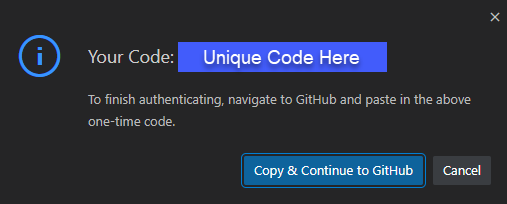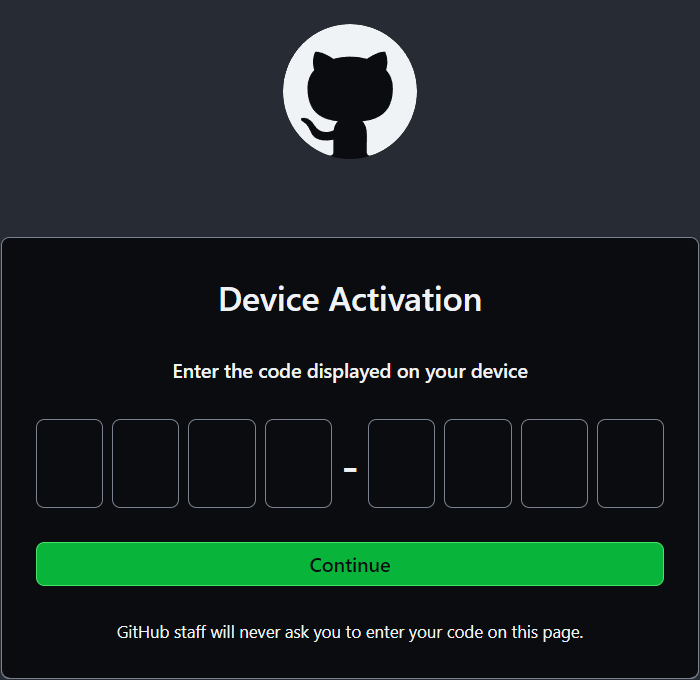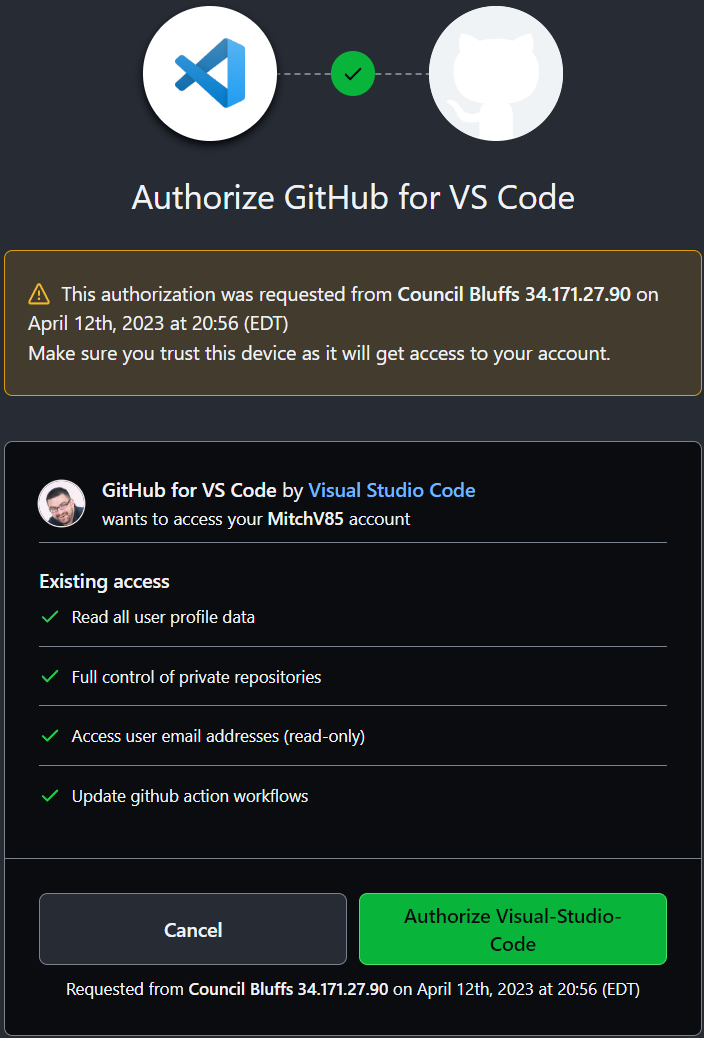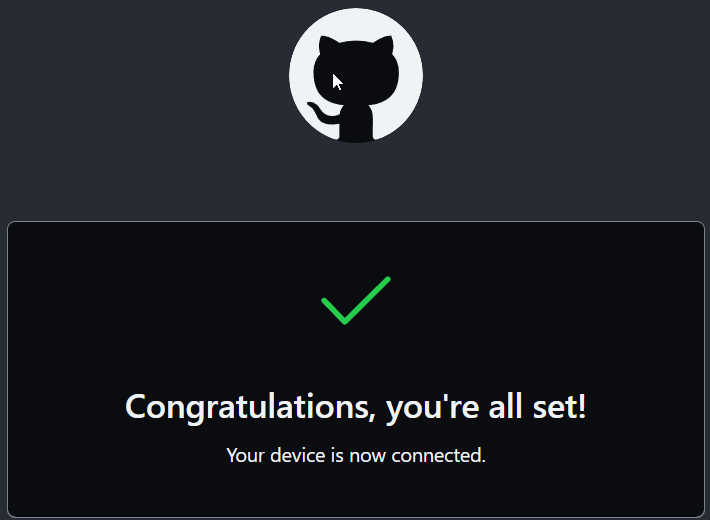Day 2 Operations¶
Our multi-site L3Ls network is working great. But, before too long, it will be time to change our configurations. Lucky for us, that time is today!
Cleaning Up¶
Before going any further, let's ensure we have a clean repo by committing the changes we've made up to this point. The CLI commands below can accomplish this, but the VS Code Source Control GUI can be used as well.
Next, we'll want to push these changes to our forked repository on GitHub.
If this is our first time pushing to our forked repository, then VS Code will provide us with the following sign-in prompt:
Choose Allow, and another prompt will come up, showing your unique login code:
Choose Copy & Continue to GitHub, and another prompt will come up asking if it's ok to open an external website (GitHub).
Choose Open and then an external site (GitHub) will open, asking for your login code.
Paste in your login code and choose Continue. You will then be prompted to Authorize VS Code.
Choose Authorize Visual-Studio-Code, and you should be presented with the coveted Green Check Mark!
Whew! Alright. Now that we have that complete, let's keep moving...
Branching Out¶
Before jumping in and modifying our files, we'll create a branch named banner-syslog in our
forked repository to work on our changes. We can create our branch in multiple ways, but we'll use
the git switch command with the -c parameter to create our new branch.
After entering this command, we should see our new branch name reflected in the terminal. It will also be reflected in the status bar in the lower left-hand corner of our VS Code window (you may need to click the refresh icon before this is shown).
Now we're ready to start working on our changes 
Login Banner¶
When we initially deployed our multi-site topology, we should have included a login banner on all our switches. Let's take a look at the AVD documentation site to see what the data model is for this configuration.
The banner on all of our switches will be the same. After reviewing the AVD documentation, we know we can accomplish this by defining the banners input variable
in our global_vars/global_dc_vars.yml file.
Add the code block below to global_vars/global_dc_vars.yml.
# Login Banner
banners:
motd: |
You shall not pass. Unless you are authorized. Then you shall pass.
EOF
Yes, that "EOF" is important!
Ensure the entire code snippet above is copied; including the EOF. This must be present for the configuration to be
considered valid
Next, let's build out the configurations and documentation associated with this change.
Please take a minute to review the results of our five lines of YAML. When finished reviewing the changes, let's commit them.
As usual, there are a few ways of doing this, but the CLI commands below will get the job done:
So far, so good! Before we publish our branch and create a Pull Request though, we have some more work to do...
Syslog Server¶
Our next Day 2 change is adding a syslog server configuration to all our switches. Once again, we'll take
a look at the AVD documentation site to see the
data model associated with the logging input variable.
Like our banner operation, the syslog server configuration will be consistent on all our switches. Because of this, we can also put this into
our global_vars/global_dc_vars.yml file.
Add the code block below to global_vars/global_dc_vars.yml.
# Syslog
logging:
vrfs:
- name: default
source_interface: Management0
hosts:
- name: 10.200.0.108
- name: 10.200.1.108
Finally, let's build out our configurations.
Take a minute, using the source control feature in VS Code, to review what has changed as a result of our work.
At this point, we have our Banner and Syslog configurations in place. The configurations look good, and we're ready to share this with our team for review. In other words, it's time to publish our branch to the remote origin (our forked repo on GitHub) and create the Pull Request (PR)!
There are a few ways to publish the banner-syslog branch to our forked repository. The commands below will
accomplish this via the CLI:
On our forked repository, let's create the Pull Request.
When creating the PR, ensure that the base repository is the main branch of your fork. This can
be selected via the dropdown as shown below:
Take a minute to review the contents of the PR. Assuming all looks good, let's earn the YOLO GitHub badge by approving and merging your PR!
Tip
Remember to delete the banner-syslog branch after performing the merge - Keep that repo clean!
Once merged, let's switch back to our main branch and pull down our merged changes.
Then, let's delete our now defunct banner-syslog branch.
Finally, let's deploy our changes.
Once completed, we should see our banner when logging into any switch. The output of the show logging command
should also have our newly defined syslog servers.
Adding additional VLANs¶
One of the many benefits of AVD is the ability to deploy new services very quickly and efficiently by modifying a small amount of data model. Lets add some new VLANs to our fabric.
For this we will need to modify the two _NETWORK_SERVICES.yml data model vars files. To keep things simple we will add two new VLANs, 30 and 40.
Copy the following pieces of data model, and paste right below the last VLAN entry, in both SITE1_NETWORK_SERVICES.yml and SITE2_NETWORK_SERVICES.yml. Ensure the -id: entries all line up.
- id: 30
name: 'Thirty'
enabled: true
ip_address_virtual: 10.30.30.1/24
- id: 40
name: 'Forty'
enabled: true
ip_address_virtual: 10.40.40.1/24
When complete, your vars file should look like this.
---
tenants:
- name: S2_FABRIC
mac_vrf_vni_base: 10000
vrfs:
- name: OVERLAY
vrf_vni: 10
svis:
- id: 10
name: 'Ten'
enabled: true
ip_address_virtual: 10.10.10.1/24
- id: 20
name: 'Twenty'
enabled: true
ip_address_virtual: 10.20.20.1/24
- id: 30
name: 'Thirty'
enabled: true
ip_address_virtual: 10.30.30.1/24
- id: 40
name: 'Forty'
enabled: true
ip_address_virtual: 10.40.40.1/24
Finally, let's build out and deploy our configurations.
Verification¶
Now lets jump into one of the nodes, s1-leaf1, and check that our new VLAN SVIs were configured, as well as what we see in the VXLAN interface and EVPN table for both local and remote VTEPs.
-
Check that the VLAN SVIs were configured.
Command
Expected Output
s1-leaf1#show ip interface brief Address Interface IP Address Status Protocol MTU Owner ----------------- --------------------- ------------ -------------- ----------- ------- Ethernet2 172.16.1.1/31 up up 1500 Ethernet3 172.16.1.3/31 up up 1500 Loopback0 10.250.1.3/32 up up 65535 Loopback1 10.255.1.3/32 up up 65535 Management0 192.168.0.12/24 up up 1500 Vlan10 10.10.10.1/24 up up 1500 Vlan20 10.20.20.1/24 up up 1500 Vlan30 10.30.30.1/24 up up 1500 Vlan40 10.40.40.1/24 up up 1500 Vlan1199 unassigned up up 9164 Vlan3009 10.252.1.0/31 up up 1500 Vlan4093 10.252.1.0/31 up up 1500 Vlan4094 10.251.1.0/31 up up 1500 -
Lets check the
VXLAN 1interface and see what changes were made there.Command
Expected Output
s1-leaf1#show run interface vxlan 1 interface Vxlan1 description s1-leaf1_VTEP vxlan source-interface Loopback1 vxlan virtual-router encapsulation mac-address mlag-system-id vxlan udp-port 4789 vxlan vlan 10 vni 10010 vxlan vlan 20 vni 10020 vxlan vlan 30 vni 10030 vxlan vlan 40 vni 10040 vxlan vrf OVERLAY vni 10Command
Expected Output
s1-leaf1#show interface vxlan 1 Vxlan1 is up, line protocol is up (connected) Hardware is Vxlan Description: s1-leaf1_VTEP Source interface is Loopback1 and is active with 10.255.1.3 Listening on UDP port 4789 Replication/Flood Mode is headend with Flood List Source: EVPN Remote MAC learning via EVPN VNI mapping to VLANs Static VLAN to VNI mapping is [10, 10010] [20, 10020] [30, 10030] [40, 10040] Dynamic VLAN to VNI mapping for 'evpn' is [1199, 10] Note: All Dynamic VLANs used by VCS are internal VLANs. Use 'show vxlan vni' for details. Static VRF to VNI mapping is [OVERLAY, 10] Headend replication flood vtep list is: 10 10.255.1.5 10.255.1.7 20 10.255.1.5 10.255.1.7 30 10.255.1.5 10.255.1.7 40 10.255.1.5 10.255.1.7 MLAG Shared Router MAC is 021c.73c0.c612 -
Now, lets check the EVPN table. We can filter the routes to only the new VLANs by specifying the new VNIs, 10030 and 10040.
Command
Expected Output
s1-leaf1#sho bgp evpn vni 10030 BGP routing table information for VRF default Router identifier 10.250.1.3, local AS number 65101 Route status codes: * - valid, > - active, S - Stale, E - ECMP head, e - ECMP c - Contributing to ECMP, % - Pending best path selection Origin codes: i - IGP, e - EGP, ? - incomplete AS Path Attributes: Or-ID - Originator ID, C-LST - Cluster List, LL Nexthop - Link Local Nexthop Network Next Hop Metric LocPref Weight Path * > RD: 10.250.1.3:10030 imet 10.255.1.3 - - - 0 i * >Ec RD: 10.250.1.5:10030 imet 10.255.1.5 10.255.1.5 - 100 0 65100 65102 i * ec RD: 10.250.1.5:10030 imet 10.255.1.5 10.255.1.5 - 100 0 65100 65102 i * >Ec RD: 10.250.1.6:10030 imet 10.255.1.5 10.255.1.5 - 100 0 65100 65102 i * ec RD: 10.250.1.6:10030 imet 10.255.1.5 10.255.1.5 - 100 0 65100 65102 i * >Ec RD: 10.250.1.7:10030 imet 10.255.1.7 10.255.1.7 - 100 0 65100 65103 i * ec RD: 10.250.1.7:10030 imet 10.255.1.7 10.255.1.7 - 100 0 65100 65103 i * >Ec RD: 10.250.1.8:10030 imet 10.255.1.7 10.255.1.7 - 100 0 65100 65103 i * ec RD: 10.250.1.8:10030 imet 10.255.1.7 10.255.1.7 - 100 0 65100 65103 iCommand
Expected Output
s1-leaf1#sho bgp evpn vni 10040 BGP routing table information for VRF default Router identifier 10.250.1.3, local AS number 65101 Route status codes: * - valid, > - active, S - Stale, E - ECMP head, e - ECMP c - Contributing to ECMP, % - Pending best path selection Origin codes: i - IGP, e - EGP, ? - incomplete AS Path Attributes: Or-ID - Originator ID, C-LST - Cluster List, LL Nexthop - Link Local Nexthop Network Next Hop Metric LocPref Weight Path * > RD: 10.250.1.3:10040 imet 10.255.1.3 - - - 0 i * >Ec RD: 10.250.1.5:10040 imet 10.255.1.5 10.255.1.5 - 100 0 65100 65102 i * ec RD: 10.250.1.5:10040 imet 10.255.1.5 10.255.1.5 - 100 0 65100 65102 i * >Ec RD: 10.250.1.6:10040 imet 10.255.1.5 10.255.1.5 - 100 0 65100 65102 i * ec RD: 10.250.1.6:10040 imet 10.255.1.5 10.255.1.5 - 100 0 65100 65102 i * >Ec RD: 10.250.1.7:10040 imet 10.255.1.7 10.255.1.7 - 100 0 65100 65103 i * ec RD: 10.250.1.7:10040 imet 10.255.1.7 10.255.1.7 - 100 0 65100 65103 i * >Ec RD: 10.250.1.8:10040 imet 10.255.1.7 10.255.1.7 - 100 0 65100 65103 i * ec RD: 10.250.1.8:10040 imet 10.255.1.7 10.255.1.7 - 100 0 65100 65103 i -
Finally, lets check from
s1-brdr1for the remote EVPN gateway.Command
Expected Output
s1-brdr1# sho bgp evpn vni 10030 BGP routing table information for VRF default Router identifier 10.250.1.7, local AS number 65103 Route status codes: * - valid, > - active, S - Stale, E - ECMP head, e - ECMP c - Contributing to ECMP, % - Pending best path selection Origin codes: i - IGP, e - EGP, ? - incomplete AS Path Attributes: Or-ID - Originator ID, C-LST - Cluster List, LL Nexthop - Link Local Nexthop Network Next Hop Metric LocPref Weight Path * >Ec RD: 10.250.1.3:10030 imet 10.255.1.3 10.255.1.3 - 100 0 65100 65101 i * ec RD: 10.250.1.3:10030 imet 10.255.1.3 10.255.1.3 - 100 0 65100 65101 i * >Ec RD: 10.250.1.4:10030 imet 10.255.1.3 10.255.1.3 - 100 0 65100 65101 i * ec RD: 10.250.1.4:10030 imet 10.255.1.3 10.255.1.3 - 100 0 65100 65101 i * >Ec RD: 10.250.1.5:10030 imet 10.255.1.5 10.255.1.5 - 100 0 65100 65102 i * ec RD: 10.250.1.5:10030 imet 10.255.1.5 10.255.1.5 - 100 0 65100 65102 i * >Ec RD: 10.250.1.6:10030 imet 10.255.1.5 10.255.1.5 - 100 0 65100 65102 i * ec RD: 10.250.1.6:10030 imet 10.255.1.5 10.255.1.5 - 100 0 65100 65102 i * > RD: 10.250.1.7:10030 imet 10.255.1.7 - - - 0 i * > RD: 10.250.1.7:10030 imet 10.255.1.7 remote - - - 0 i * > RD: 10.250.2.7:10030 imet 10.255.2.7 remote 10.255.2.7 - 100 0 65203 iCommand
Expected Output
s1-brdr1# sho bgp evpn vni 10040 BGP routing table information for VRF default Router identifier 10.250.1.7, local AS number 65103 Route status codes: * - valid, > - active, S - Stale, E - ECMP head, e - ECMP c - Contributing to ECMP, % - Pending best path selection Origin codes: i - IGP, e - EGP, ? - incomplete AS Path Attributes: Or-ID - Originator ID, C-LST - Cluster List, LL Nexthop - Link Local Nexthop Network Next Hop Metric LocPref Weight Path * >Ec RD: 10.250.1.3:10040 imet 10.255.1.3 10.255.1.3 - 100 0 65100 65101 i * ec RD: 10.250.1.3:10040 imet 10.255.1.3 10.255.1.3 - 100 0 65100 65101 i * >Ec RD: 10.250.1.4:10040 imet 10.255.1.3 10.255.1.3 - 100 0 65100 65101 i * ec RD: 10.250.1.4:10040 imet 10.255.1.3 10.255.1.3 - 100 0 65100 65101 i * >Ec RD: 10.250.1.5:10040 imet 10.255.1.5 10.255.1.5 - 100 0 65100 65102 i * ec RD: 10.250.1.5:10040 imet 10.255.1.5 10.255.1.5 - 100 0 65100 65102 i * >Ec RD: 10.250.1.6:10040 imet 10.255.1.5 10.255.1.5 - 100 0 65100 65102 i * ec RD: 10.250.1.6:10040 imet 10.255.1.5 10.255.1.5 - 100 0 65100 65102 i * > RD: 10.250.1.7:10040 imet 10.255.1.7 - - - 0 i * > RD: 10.250.1.7:10040 imet 10.255.1.7 remote - - - 0 i * > RD: 10.250.2.7:10040 imet 10.255.2.7 remote 10.255.2.7 - 100 0 65203 i
Provisioning new Switches¶
Our network is gaining popularity, and it's time to add a new Leaf pair into the environment! s1-leaf5 and s1-leaf6 are ready to be provisioned, so let's get to it.
Branch Time¶
Before jumping in, let's create a new branch for our work. We'll call this branch add-leafs.
Now that we have our branch created let's get to work!
Inventory Update¶
First, we'll want to add our new switches, named s1-leaf5 and s1-leaf6, into our inventory file. We'll add them
as members of the SITE1_LEAFS group.
Add the following two lines under s1-leaf4 in sites/site_1/inventory.yml.
The sites/site_1/inventory.yml file should now look like the example below:
sites/site_1/inventory.yml
---
SITE1:
children:
CVP:
hosts:
cvp:
SITE1_FABRIC:
children:
SITE1_SPINES:
hosts:
s1-spine1:
s1-spine2:
SITE1_LEAFS:
hosts:
s1-leaf1:
s1-leaf2:
s1-leaf3:
s1-leaf4:
s1-brdr1:
s1-brdr2:
s1-leaf5:
s1-leaf6:
SITE1_NETWORK_SERVICES:
children:
SITE1_SPINES:
SITE1_LEAFS:
SITE1_CONNECTED_ENDPOINTS:
children:
SITE1_SPINES:
SITE1_LEAFS:
Next, let's add our new Leaf switches into sites/site_1/group_vars/SITE1_FABRIC.yml.
These new switches will go into S1_RACK4, leverage MLAG for multi-homing and use BGP ASN# 65104.
Just like the other Leaf switches, interfaces Ethernet2 and Ethernet3 will be used to connect
to the spines.
On the spines, interface Ethernet9 will be used to connect to s1-leaf5, while Ethernet10
will be used to connect to s1-leaf6.
Starting at line 64, add the following code block into sites/site_1/group_vars/SITE1_FABRIC.yml.
- group: S1_RACK4
bgp_as: 65104
nodes:
- name: s1-leaf5
id: 7
mgmt_ip: 192.168.0.28/24
uplink_switch_interfaces: [ Ethernet9, Ethernet9 ]
- name: s1-leaf6
id: 8
mgmt_ip: 192.168.0.29/24
uplink_switch_interfaces: [ Ethernet10, Ethernet10 ]
Warning
Make sure the indentation of RACK4 is the same as RACK3, which can be found on line 52
The sites/site_1/group_vars/SITE1_FABRIC.yml file should now look like the example below:
sites/site_1/group_vars/SITE1_FABRIC.yml
---
fabric_name: SITE1_FABRIC
# Set Design Type to l3ls-evpn
design:
type: l3ls-evpn
# Spine Switches
spine:
defaults:
platform: cEOS
loopback_ipv4_pool: 10.250.1.0/24
bgp_as: 65100
nodes:
- name: s1-spine1
id: 1
mgmt_ip: 192.168.0.10/24
- name: s1-spine2
id: 2
mgmt_ip: 192.168.0.11/24
# Leaf Switches
l3leaf:
defaults:
platform: cEOS
spanning_tree_priority: 4096
spanning_tree_mode: mstp
loopback_ipv4_pool: 10.250.1.0/24
loopback_ipv4_offset: 2
vtep_loopback_ipv4_pool: 10.255.1.0/24
uplink_switches: [ s1-spine1, s1-spine2 ]
uplink_interfaces: [ Ethernet2, Ethernet3 ]
uplink_ipv4_pool: 172.16.1.0/24
mlag_interfaces: [ Ethernet1, Ethernet6 ]
mlag_peer_ipv4_pool: 10.251.1.0/24
mlag_peer_l3_ipv4_pool: 10.252.1.0/24
virtual_router_mac_address: 00:1c:73:00:00:99
node_groups:
- group: S1_RACK1
bgp_as: 65101
nodes:
- name: s1-leaf1
id: 1
mgmt_ip: 192.168.0.12/24
uplink_switch_interfaces: [ Ethernet2, Ethernet2 ]
- name: s1-leaf2
id: 2
mgmt_ip: 192.168.0.13/24
uplink_switch_interfaces: [ Ethernet3, Ethernet3 ]
- group: S1_RACK2
bgp_as: 65102
nodes:
- name: s1-leaf3
id: 3
mgmt_ip: 192.168.0.14/24
uplink_switch_interfaces: [ Ethernet4, Ethernet4 ]
- name: s1-leaf4
id: 4
mgmt_ip: 192.168.0.15/24
uplink_switch_interfaces: [ Ethernet5, Ethernet5 ]
- group: S1_BRDR
bgp_as: 65103
evpn_gateway:
evpn_l2:
enabled: true
evpn_l3:
enabled: true
inter_domain: true
nodes:
- name: s1-brdr1
id: 5
mgmt_ip: 192.168.0.100/24
uplink_switch_interfaces: [ Ethernet7, Ethernet7 ]
evpn_gateway:
remote_peers:
- hostname: s2-brdr1
bgp_as: 65203
ip_address: 10.255.2.7
- name: s1-brdr2
id: 6
mgmt_ip: 192.168.0.101/24
uplink_switch_interfaces: [ Ethernet8, Ethernet8 ]
evpn_gateway:
remote_peers:
- hostname: s2-brdr2
bgp_as: 65203
ip_address: 10.255.2.8
- group: S1_RACK4
bgp_as: 65104
nodes:
- name: s1-leaf5
id: 7
mgmt_ip: 192.168.0.28/24
uplink_switch_interfaces: [ Ethernet9, Ethernet9 ]
- name: s1-leaf6
id: 8
mgmt_ip: 192.168.0.29/24
uplink_switch_interfaces: [ Ethernet10, Ethernet10 ]
Next - Let's build the configuration!
Important
Interfaces Ethernet9 and Ethernet10 do not exist on the Spines. Because of this, we
will not run a deploy command since it would fail.
Please take a moment and review the results of our changes via the source control functionality in VS Code.
Finally, we'll commit our changes and publish our branch. Again, we can use the VS Code Source Control GUI for this, or via the CLI using the commands below:
Backing Out Changes¶
Ruh Roh. As it turns out, we should have added these leaf switches to an entirely new site. Oops! No worries, because we used our add-leafs branch, we can switch back to our main branch and then delete our local copy of the add-leafs branch. No harm or confusion related to this change ever hit the main branch!
Finally, we can go out to our forked copy of the repository and delete the add-leafs branch.
Great Success!
Congratulations. You have now successfully completed initial fabric builds and day 2 operational changes without interacting with any switch CLI!






